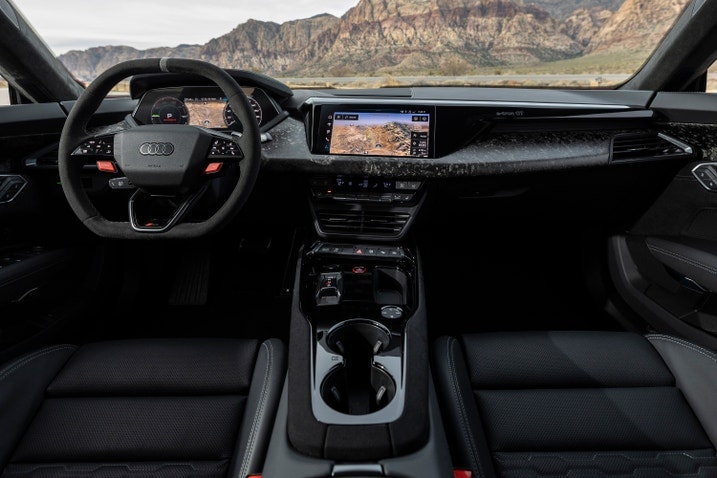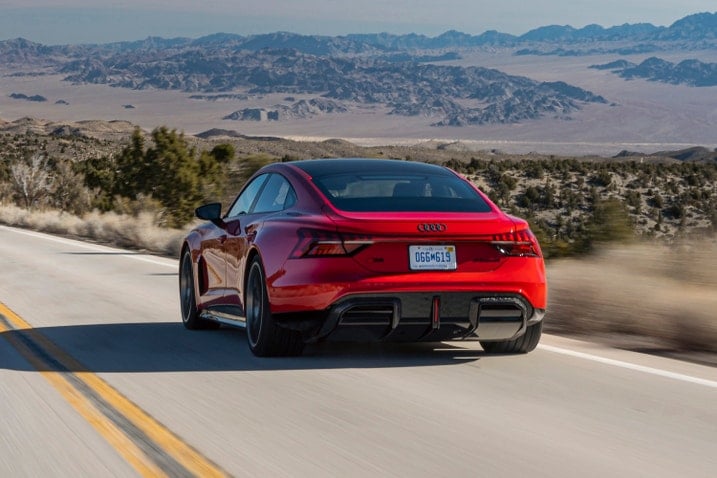- Audi's electric E-tron GT gets a new name and more performance for 2025.
- Maximum power on the top-shelf RS E-tron GT Performance is 912 horsepower.
- Big upgrades across the board don't radically change the E-tron GT formula.
2025 Audi RS E-Tron GT Performance First Drive: More Power, More Poise
Audi's E-tron GT gets big upgrades across the board, but you'll pay for it
Since its introduction in 2020, Audi's E-tron GT has been a striking car. While its distinctive, futuristic style isn't for everyone, it has always offered a great blend of performance and comfort with only one problem: the Porsche Taycan. The GT's corporate cousin has always been just that little bit more stylish, performant and desirable — particularly for anyone wanting something with a longer roof.
For 2025, Audi's turning up the wick. The RS E-tron GT Performance now makes 912 horsepower, rolls on a wildly advanced new suspension, and looks sharper, too. But is it enough to finally topple the Taycan?
What's new?
As far as visual refreshes go, there's not much new to catch the eye on the 2025 E-tron GT. Even Audi fanatics will have to look twice.
Up front, a subtly refined nose has been opened up, allowing substantially more cooling. The biggest change is out back, where a racier diffuser is slung beneath a reprofiled bumper. Where the old car's diffuser just looked like a curious protuberance, this new one has the appearance of something potentially functional.
That rear diffuser, plus the side skirts and mirrors, can optionally be had in forged carbon, made from shredded bits of the stuff bonded in resin. It creates a striking look, but one that's a bit too messy for my tastes.
Interior revisions
Audi took a light touch with the E-tron's interior changes as well. The dashboard shape is the same, now bisected with a generous carbon-fiber panel available in your choice of traditional woven or, again, the funkier forged stuff if you prefer more sparkle and less symmetry.
The bigger change is the steering wheel, and I'm sorry to say it's not a good one. Where the old wheel had tactile knobs and buttons embedded in the spokes, the new one swaps those out for capacitive touch pads, much like those found on the Volkswagen ID 4. They're harder to find by touch yet easier to accidentally actuate. I turned the volume up three times by mistake during my time behind the wheel.
There are two new proper buttons, though, and big, shiny red ones at that. The one on the right, labeled "RS," cycles through the car's various performance-related driving modes. The one on the left says "Boost," and you can probably guess what that does: 10 seconds of maximum power from the thoroughly revised drivetrain.
More, more, more
The revisions start with a refreshed battery pack with a capacity of 105 kWh (95 kWh usable), an increase of 11.6 kWh. It charges faster at a wider range of temperatures, too. A maximum rate of 320 kW means the 10%-to-80% charge cycle is handled in 18 minutes. Maximum range jumps 51 miles to 300 miles on the S E-tron GT. The RS E-tron GT Performance offers a 29-mile gain over its predecessor, to 278 miles.
Why less range on the RS? Because more power. 912 hp in launch control mode, to be specific, which is enough to sprint from a standstill to 60 mph in 2.4 seconds. That's well beyond "wow" territory, enough g-forces to be genuinely uncomfortable. I felt like my eyeballs were in danger of popping backward into my skull. Pull this unannounced, and your passengers won't be impressed — they'll be terrified.
Yes, there are quicker EVs in the 0-60 dash, but few maintain that thrust this well. The E-tron GT was still crushing my internal organs with accelerative force when I topped 130 mph and ran out of road.
You can only get that full dollop of power when using launch control, but you can get close underway by hitting the aforementioned Boost button. With or without, the RS E-tron GT Performance surges forward with eagerness at the slightest twitch of your right foot. It's stunningly quick at any speed.
Re-sprung
As stellar as the acceleration is, the available active suspension in the RS E-tron GT Performance is the bigger step forward. A new hydraulic setup not only hikes the car up 2 inches when you open the door, making sliding in and out much easier, but also obviates the need for anti-roll bars. The car mitigates roll purely by modulating the compression on each corner and can actually be made to lean into the corners, even dipping the nose under acceleration and raising it again under braking.
It's the same basic setup as Active Ride, found in the latest Porsche Panamera and Taycan, and it works equally well here, creating a sensation that is strange but nevertheless easier on the stomach for your passengers. They'll appreciate the ride quality, too, despite the 21-inch wheels and low-profile tires.
In the corners, the RS E-tron GT Performance oozes confidence and poise, turning in quickly thanks to revised steering ratios that help to hide this EV's 5,137-pound weight. The steering is quick but a bit muddy. Sadly, while you can dial up a custom drive mode with your choice of engine responsiveness and suspension feel, you can't reduce the steering resistance.
The brakes, too, are a challenge to modulate. The 2025 E-tron GT can now provide up to 400 kW of recuperative braking energy, but I found the pedal feel awkward, which often had me lurching to a stop. Also, sadly, one-pedal driving is still absent. Lift-off recuperative braking has been nearly doubled over last year's car, but twice nothing is still nothing. When you lift off the gas, the E-tron GT still just glides along.
Does it top the Taycan?
Audi's 2025 RS E-tron GT Performance offers a big leap forward in dynamic performance. The bar has been raised, but this car's biggest competition, the Porsche Taycan, has also received virtually all the same updates. At $167,000, Audi's RS E-tron GT Performance offers a little more speed for a little less cost than the $175,000 Taycan Turbo, but that's a scant difference in this elevated category.









 by
by  edited by
edited by